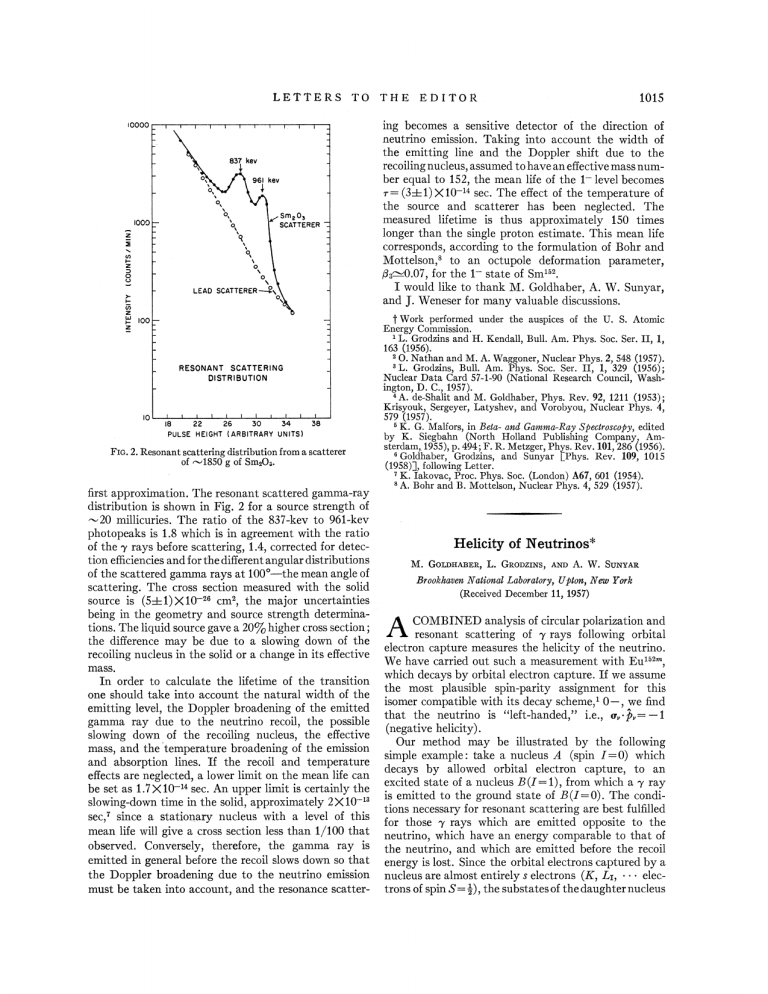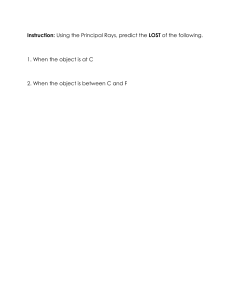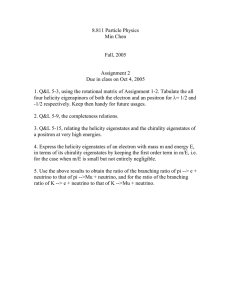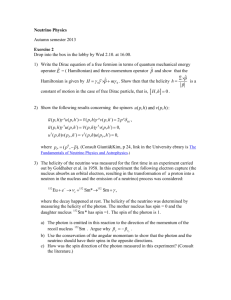
LETTERS IOOO0 TO THE ED IVOR ing becomes a sensitive detector of the direction of neutrino emission. Taking into account the width of the emitting line and the Doppler shift due to the recoiling nucleus, assumed to have an effec;tive mass number equal to 152, the mean life of the 1 level becomes r= (3&1)X10 sec. The effect of the temperature of the source and scatterer has been neglected. The measured lifetime is thus approximately 150 times longer than the single proton estimate. This mean life corresponds, according to the formulation of Bohr and Mottelson, ' to an octupole deformation parameter, Ps~0. 07, for the 1 state of Sm'". I would like to thank M. Goldhaber, A. W. Sunyar, and J. Weneser for many valuable discussions. I 0~ IOOO— TERER Z " : Ch IZ D O O 40 Z $ Work performed under the auspices of the U. S. Atomic Energy Commission. ' L. Grodzins and H. Kendall, Bull. Am. Phys. Soc. Ser. II, 1, 163 (1956). ' O. Nathan and M. A. Waggoner, Nuclear Phys. 2, 548 (1957). 3L. Grodzins, BulL Am. Phys. Soc. Ser. II, 1, 329 (1956); Nuclear Data Card 57-1-90 (National Research Council, Washington, D. C., 1957). 'A. de-Shalit and M. Goldhaber, Phys. Rev. 92, 1211 (1953); Krisyouk, Sergeyer, Latyshev, and Vorobyou, Nuclear Phys. 4, 579 (1957). 5 K. G. Malfors, in Betu- und Gummu-Ruy Spectroscopy, edited Amby K. Siegbahn (North Holland Publishing Company sterdam, 1955), p. 494; F. R. Metzger, Phys. Rev. 101, 286 (1956). ~ Goldhaber, Grodzins, and Sunyar )Phys. Rev. 109, 1015 100— RESONANT SCATTERING OISTRI BUTION IO I I I I I I I i I I 34 26 30 l8 22 PULSE HEIGHT (ARBITRARY UNITS) I 38 FIG. 2. Resonant scattering distribution from a scatterer of ~1850 g of Sm20~. first approximation. The resonant scattered gamma-ray distribution is shown in Fig. 2 for a source strength of 20 millicuries. The ratio of the 837-kev to 961-kev photopeaks is 1.8 which is in agreement with the ratio of the p rays before scattering, 1.4, corrected for detection e%ciencies and for the different angular distributions of the scattered gamma rays at 100' the mean angle of scattering. The cross section measured with the solid source is (5&1)X10 's cm', the major uncertainties being in the geometry and source strength determinations. The liquid source gave a 20% higher cross section; the diGerence may be due to a slowing down of the recoiling nucleus in the solid or a change in its effective mass. In order to calculate the lifetime of the transition one should take into account the natural width of the emitting level, the Doppler broadening of the emitted gamma ray due to the neutrino recoil, the possible slowing down of the recoiling nucleus, the effective mass, and the temperature broadening of the emi. ssion and absorption lines. If the recoil and temperature effects are neglected, a lower limit on the mean life can be set as 1.7X10 '4 sec. An upper limit is certainly the slowing-down time in the solid, approximately 2&(10 sec, ~ since a stationary nucleus with a level of this mean life will give a cross section less than 1/100 that observed. Conversely, therefore, the gamma ray is emitted in general before the recoil slows down so that the Doppler broadening due to the neutrino emission must be taken into account, and the resonance scatter- — " (1958)g, following Letter. r K. Iakovac, Proc. Phys. Soc. (London) A67, 601 (1954). ' A. Bohr and B. Mottelson, Nuclear Phys. 4, 529 (1957). Helicity of Neutrinos" M. GQLDHABER, L. Brookhuven E'utionu/ GRoDzINs, Luborutory, A&D A. W. SUNYAR Upton, 1Vem Fork (Received December 11, 1957) COMBINED analysis of circular polarization and resonant scattering of p rays following orbital electron capture measures the helicity of the neutrino. We have carried out such a measurement with Ku'", which decays by orbital electron capture. If we assume the most plausible spin-parity assignment for this isomer compatible with its decay scheme, ' 0 —,we hand that the neutrino is "left-handed, i.e., a„p„= —1 (negative helicity) . Our method may be illustrated by the following simple example: take a nucleus 2 (spin I=O) which decays by allowed orbital electron capture, to an excited state of a nucleus B(I=1), from which a p ray is emitted to the ground state of B(I=O). The conditions necessary for resonant scattering are best fulfilled for those p rays which are emitted opposite to the neutrino, which have an energy comparable to that of the neutrino, and which are emitted before the recoil energy is lost. Since the orbital electrons captured by a . elecnucleus are almost entirely s electrons (E, Lr, trons of spin S = —',), the substates of the daughter nucleus " LETTERS 1016 Eu TO THE E EDITOR The e ectiveness of this ma netic y c ec experiments with a Cs"' 7-ra sour in a manner similarr too th at d escribed previousl .' oton t'ic fi e ld reversal on theep e hotosignificant effect of maagne noticed multiplier output was no ice w h en two narrow acset on the steeply sloping iowceptance channels weree se — ev an ig -energy wings of the 661-kev p h otopeak, respectively. 10 mg of e source was p roduced y bombarding u2 3 in the Brookhaven reactor. In t ical r 50— d f carried out. The in length from 3 too 9 hours ours were w ' scatt ere" radiation is shown in F'ig.. 2.. t contains both p rays emitted from the 960-ke SOURCE ~~ANALYZING gg ~ MAGNET «z n viz' SCALE Smg 03 SCATTERER sy LD wax / (T / RCA / / 6342 II i Mu METAL SHIELD I F&G. 1. Experimental arrangement for ization of re o a t sca cattered ere p-rays. Weight of Sm20& scatterer: 1850 grams. has ne g ativ 3)&10' racketed the photopeaks, a total of w ic ' ' a e . Inn 6 runs carried out in thee counts were accumulated. 8= E arrangement shown in Fig. 1, an effect X— after the nonresonant back r ere + is defined as the counting rate with the an as the counting when hen a neutrino is emitted in the Z dir the neutrino m 1 —) with rate I I I I I I I I 1 IP TH SCATTERER emission of neutrinos -e ectron capture. This is followed b y an E1 p-ray o 0 kev to the ground state (0+). The excited state has a mean life of (3&1)X10 '4 s ro zins. us everi in a solid soulce e p-ray emission takes lace e recoi nucleus has changed appreused is The ex perimental arrangement use ' u ' source is inserted Fig. 1. Thee Eu'52~ ~ever e w ic is alternatel w ic ma- pointing down. e e y irection is the same as that of the ne emen o the circular polarization of e y rays whic are resonant-scatt ere d b y t h e nu' n of thee neutrino, , yie ds directly the helicity o conservat erva ion es ony t e well-established aws of moment um and angular moment um. To carry out this measurem rement we have used a c eus w ich a pp earss to have the properties postulated in t e example given: 63Eu'" 9.3 hr ~~ in field reversals was used such that the deca c ' i e. o e ects of field reversal or deca ecay were noticed in channel C. Ch annel A exhibited a possible small magnetic field effect which was l 2"x3 / 8, formed ~ show11 v) I- IP 2 0 ln pass throu h the m rom a Sm203 scatterer (26..8%%u'& Sm '") '~, and detected in ' ' ' a 2-in. X3-, -m. cylindrical Nai (Tl) scintillation counter.r. The photomultiplier (RCA 6342~ i y an iron cylinder and a mu-metal shield IP I I8 I I 20 22 I 24 26 PULSE HEIGHT IN I I I 30 28 32 34 36 VOLTS Fr.G. 2. Re sonant-scattered p rays of Eu'5 Fi . with unmagnetized iron. taken with arrangement shownn in Fig. ows nonresonant ackground (including natural LETTERS TO TH E E D I TOR The magnet response was tested with the bremsstrahlung from a Sr"+Y"source, for which the helicity is negative, ' rrr p, = — 1. Eu"' runs were made with both solid and dissolved sources (HC1 solution), and both gave similar results. The eGective path length of the 960-kev p ray in the magnet was somewhat uncertain, partly because of the extent of the source and partly because of a lack of knowledge of the field distribution in the return path. Ke estimate that the average path is equivalent to 3&0.3 mean free paths in fully magnetized iron. From this we expect an effect of 3=&0.025 with an accuracy of 10%, if the 960-kev y rays are 100% circularly polarized, with the —sign corresponding to positive helicity (spin parallel to their direction of propagation) and the sign to negative helicity. Thus we And that in our case the p rays are (68&14%) circularly polarized, and that their helicity is negative. As a further check, 3 runs were carried out with a shorter magnet of length 3-', in. with the source on top of the magnet. In this case also a negative helicity was found, the circular polarization being + (66& 15%). From the energy of the neutrinos emitted, the width of the p-ray line, and the fact that the circular polarization varies with the direction of emission of the p ray relative to the neutrino as coso, we calculate that a circular polarization, which in the ideal case discussed above would be 100%, would be reduced to 75%. This should be further reduced to a slight extent because of the e feet of thermal motion and because some p rays are emitted after the recoil has changed momentum. Thus our result seems compatible with spin 0 —for and 100% negative helicity of the neutrinos emitted in orbital electron capture. ' In all formulations of P-decay theory no distinction is made between the neutrino emitted in orbital electron capture and that emitted in P+ decay. Taken together with the fact that the helicity of the positrons in a Gamow-Teller transition is positive4 or with the fact that positrons are emitted from oriented nuclei in the direction in which the nuclear spin is pointing, ' our result indicates that the Gamow-Teller interaction is axial vector (A) for positron emitters, in agreement with the conclusions of Hermannsfeldt et al. ' These authors show that all recoil experiments with p+ emitters are compatible with AU, but not with TS interactions which have been reported for P emitters (largely based on He' recoil experiments). ' The A U combination may be compatible with lepton conservation and a universal Fermi interaction as pointed out by Sudarshan and Marshak' and by Feynman and Gell-Mann. ' This view is strengthened by the recent results showing positive helicity for the positrons from p+ decay. It would therefore seem desirable to apply the method described here to a p emitter in order to determine the helicity of the antineutrino. Although the analysis of such an experiment is considerably more complicated, it may prove possible to reach a decision between A and T, Eu'", " 1017 is independent periments. We wish to thank discussions. t of the which J. "classical" recoil ex- Weneser for many valuable *Work performed under the auspices of the U. S. Atomic Energy Commission. r L. Grodzins, Phys. Rev. 109, 1015 (1958), preceding Letter. s Goldhaber, Grodzins, and Sunyar, Phys. Rev. 106, 826 (1957). ' It is worthwhile to inquire how our conclusions are affected if the less plausible spin-parity assignments of 1W are assumed for Eu'" . For (unpublished) the case of a 1 6nds ~1=+0+ transition, (o. . uv)Ls IGorl'~~2IGorl IGorl'+IGrl' J. Weneser IGvl] where GGT=MGTCGT and Gy=3f FCp. This has been calculated on the simplifying assumption that the two-component neutrino theory and time-reversal invariance hold see T. D. Lee and C. N. Yang, Phys. Rev. 105, 1671 (1957)g. For a neutrino helicity of 1 the photon helicity varies from +0.5 to 1.0, and for a neutrino helicity of +1 the photon helicity varies from 0.5 to 0. Considering the reduction factors discussed above, the experimentally found helicity of the p rays is in agreement with the assumption of neutrinos of negative helicity, even if Eu'"m has spin-parity 1 In the other very unlikely case of a 1+ assignment to we could not at present draw a definite conclusion concerning the neutrino helicity. The theory for 6rst forbidden transitions is being investigated by A. M. Bincer. 4 L. A. Page and M. Heinberg, Phys. Rev. 106, 1220 (1957). 5 Ambler, Hayward, Hoppes, Hudson, and Wu, Phys. Rev. 106, 1361 (1957); Postma, Huiskamp, Miedema, Steenland, Tolhoek, and Gorter, Physica 23, 259 (1957). ' Hermannsfeldt, Maxson, Stahelin, and Allen, Phys. Rev. 107, I — — +1. Eu'", — —. 641 (1957). r B. M. Rustad and S. L. Ruby, Phys. Rev. 97, 991 (1955). C. G. Sudarshan and R. Marshak, Phys. Rev. (to be published). R. P. Feynman and M. Gell-Mann, Phys. Rev. 109, 193 'E. (1958). "Culligan, Frank, Holt, Kluyver, and Massam, Nature 180, 751 (1957). t Pote added in proof, According to a private communication from Professor V. L. Telegdi, a refinement of the experiment of — Burgy, Epstein, Krohn, Novey, Raboy, Ringo, and Telegdi, Rev. 107, 1731 (1957)g favors V—A for the P interaction. I Phys. of Nuclear Wave Functions Axial Symmetry R. K. Department NEsBET of Physics, Boston University, Boston, 3IIassachzssetts (Received November 25, 1957) ' 'N connection with recent work deriving the principal . . results of the Bohr-Mottelson theory from the nuclear shell model with axially symmetrical (spheroidal) potential, ' it should be pointed out that there is a simple theorem which relates the spheroidal potential to the a priori Hartree-Fock method. This theorem " follows trivially from results given different context in earlier papers. in a somewhat The Hartree-Fock method, for the present purpose, is to be thought of as a variational calculation which attempts to find the single Slater determinant (a normalized many-particle wave function constructed as an antisymmetrized product of single-particle wave functions) for which the mean value of the tota, l energy is a


